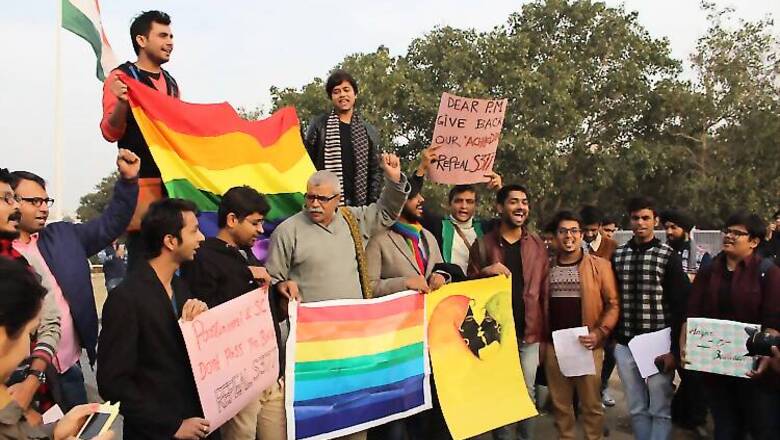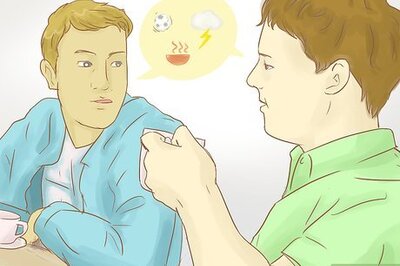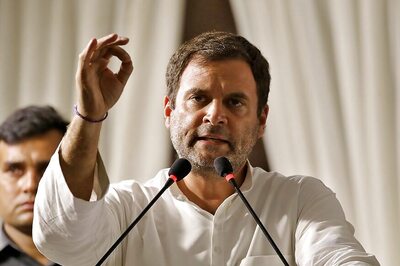
views
New Delhi: The LGBT community and their supporters have welcomed the Supreme Court decision to transfer the case on Section 377 to a five-judge Constitution bench. For them, it is a significant development and a major boost for them. If the SC had dismissed all 8 curative petitions, it would have closed for a judicial review of Section 377 which criminalises homosexuality.
They are now anxiously waiting for the five-judge bench to start the hearing. The SC is yet to fix a date for the hearing. Since the curative petition system was started about 12 years back in 2002, only a total of two curative petitions have succeeded so far from out of hundreds of curative petitions that are filed every year. Thus, in curative petitions also, the success rate is very, very low.
The Muslim Personal Law Board and the Churches of India were also present during the hearing. These organisations were opposing the curative petition. They wanted the SC to dismiss them. Once the five-judge bench of the SC begins hearing, they are likely to oppose the decriminalisation of Section 377.
Main points of the SC order:
- The SC re-opens hearing on the Section 377 of the IPC
- The SC agrees to hear all 8 curative petitions
- Ray of hope for the LGBT community
- They can argue before the 5 Judge Bench demanding decriminalisation of Section 377
- After a lengthy argument, the SC to decide on the case
- If the SC 3 Judge bench had dismissed the curative petitions, it would have ended the legal debate
- It is a big news for the LGBT community
Ashok Row Kavi, noted gay rights activist, said: “It is a great step forward for the LGBT community. The Supreme Court has taken a very good decision. I am so happy. Lot of states have prohibited sex education. Homosexuality is just another form of sexuality. For me it is a very big move”
"A small law like this is an obstacle. It makes life tough for the LGBT. I find the SC decision to open the case again is a very progressive step," said Nil, a fashion designer.
Alternative Law Forum, Bengaluru, called it a "very good move by the SC". "We are all happy.”
"I am happy that an error is being corrected. This is only the first step. I look forward to the day when the SC will uphold the judgement of the Delhi High Court," added former union minister P Chidambaram.
Curative Petition:
In fact, there is no provision in the Constitution regarding curative petition. After the dismissal of an appeal, the only opportunity a litigant can avail of is Article 137, which empowers the top court to review any judgment or order pronounced by it.
It can be used by an aggrieved person who was not a party to the proceedings or was not heard. It can also be filed where a judge failed to disclose his/her connection in any manner with the subject matter before him/her.
A curative petition is generally not heard in open court and is circulated to a bench of the three senior-most judges and the judges who passed the judgment under challenge, if the latter were still available.
History of Curative Petition:
It is very rare chance indeed that a review petition will succeed in the Supreme Court. Unless a Judge has retired, the review petition goes before the same Bench which heard the case previously. Moreover, the review petition first goes before those Judges in their chamber and not in the open court (which means no oral arguments by counsel). It is only when the Judges find something substantial in the review petition that they decide to hear such petition in the open court permitting oral arguments by counsel. But, that is very rare indeed.
As per the Supreme Court Rules, a review petition will not be entertained in a criminal proceeding except on the ground of an error apparent on the face of the record. And, in a civil proceeding, a review petition is not entertained except on the ground mentioned in Order XLVII, Rule I of the Civil Procedure Code, which in turn means grounds such as: (1) the discovery of new and important matter or evidence which, after the exercise of due diligence, was not within the knowledge or could not be produced by the person at the time when the decree was passed or order made; or, (2) some mistake or error apparent on the face of the record; or, (3) any other sufficient reason.
Thus, a review petition is maintainable only on limited grounds. It is also the normal human tendency not to accept the review petition sometimes even if the judges themselves had committed an error. However, still people try by filing review petitions in a routine manner. Hoping against hope. In fact, some people try even a curative petition after rejection of their review petition in the Supreme Court.
It is pertinent to mention that the system of curative petition was started after the decision of the Supreme Court in the case of Rupa Ashok Hurra vs. Ashok Hurra, (2002) 4 SCC 388 : AIR 2002 SC 1771. A tedious process has been laid down for filing a curative petition, inter alia, including, that the curative petition shall contain a certification by a Senior Advocate with regard to the fulfilment of the requirements for filing the curative petition.
If the information is correct, since the curative petition system was started about 12 years back in 2002 in the aforesaid judgment, only a total of two curative petitions have succeeded so far from out of hundreds of curative petitions that are filed every year. Thus, in curative petitions also, the success rate is very, very low.


















Comments
0 comment